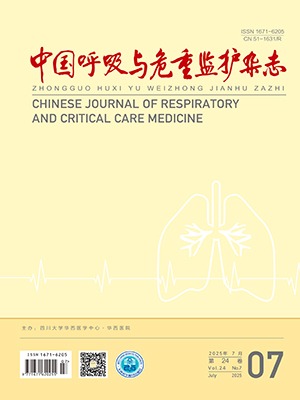| 1. |
王凡, 陈旭昕, 韩志海. 重症肺炎早期患者外周血T淋巴细胞亚群比例变化及预后预测效能. 山东医药, 2021, 61(27): 32-36.
|
| 2. |
陈小蓉, 曾惠清, 王洺辉, 等. 生物学标志物在渗出性胸腔积液诊断的研究进展. 中国呼吸与危重监护杂志, 2021, 20(2): 148-152.
|
| 3. |
Jackson C, Linos K, Liu X. Malignant melanotic nerve sheath tumor in pleural effusion: deceitful cytology with significant repercussions. Diagn Cytopathol, 2022, 50(3): E76-E80.
|
| 4. |
Kotalwar SG, Prakash AK, Chatterjee P, et al. Comparison of diagnostic accuracy of digital chest X-ray images between PACS and WhatsApp Messenger in resource poor setting. Indian J Tuberc, 2021, 68(2): 186-194.
|
| 5. |
Abd Karim SH, Wan Zain WZ, et al. Empyema thoracis presented as giant back abscess. Radiol Case Rep, 2021, 16(5): 1061-1064.
|
| 6. |
Asrir A, Tardiveau C, Coudert J, et al. Tumor-associated high endothelial venules mediate lymphocyte entry into tumors and predict response to PD-1 plus CTLA-4 combination immunotherapy. Cancer Cell, 2022, 40(3): 318-334, e9.
|
| 7. |
Vanikova S, Koladiya A, Musil J. OMIP-080: 29-Color flow cytometry panel for comprehensive evaluation of NK and T cells reconstitution after hematopoietic stem cells transplantation. Cytometry A, 2022, 101(1): 21-26.
|
| 8. |
Patel C, Zagon IS, Pearce-Clawson M, et al. Timing of treatment with an endogenous opioid alters immune response and spinal cord pathology in female mice with experimental autoimmune encephalomyelitis. J Neurosci Res, 2022, 100(2): 551-563.
|
| 9. |
中国医师协会急诊医师分会. 中国急诊重症肺炎临床实践专家共识. 中国急救医学, 2016, 36(2): 97-107.
|
| 10. |
王崇杰, 骆学勤, 罗健, 等. 46例重症肺炎支原体肺炎合并胸腔积液患儿临床及预后分析. 临床儿科杂志, 2020, 38(4): 269-274.
|
| 11. |
Shiraishi Y, Kryukov K, Tomomatsu K, et al. Diagnosis of pleural empyema/parapneumonic effusion by next-generation sequencing. Infect Dis (Lond), 2021, 53(6): 450-459.
|
| 12. |
Wik JA, Chowdhury A, Kolan S, et al. Endogenous glutamine is rate-limiting for anti-CD3 and anti-CD28 induced CD4+ T-cell proliferation and glycolytic activity under hypoxia and normoxia. Biochem J, 2022, 479(11): 1221-1235.
|
| 13. |
Kamrani A, Soltani-Zangbar MS, Shiri S, et al. TIGIT and CD155 as immune-modulator receptor and ligand on CD4+ T cells in preeclampsia patients. Immunol Invest, 2021, 51(4): 1023-1038.
|
| 14. |
Ba W, Yang HH, Wang WJ, et al. CD8+ mycosis fungoides with ichthyosiform clinical presentation and angiocentric feature. J Cutan Pathol, 2022, 49(5): 487-490.
|
| 15. |
刘冉, 许磊. 纤维支气管镜早期介入治疗儿童重症肺炎支原体肺炎合并肺不张的临床疗效. 中国内镜杂志, 2022, 28(11): 71-76.
|
| 16. |
鲁成, 庞家栋, 刘永明, 等. 新型冠状病毒肺炎患者入院时外周血血红蛋白水平及其与病程的相关性. 山东医药, 2021, 61(6): 6-9.
|
| 17. |
钱婧, 魏友加, 程毅菁, 等. 儿童坏死性肺炎临床特征及危险因素分析. 北京大学学报(医学版), 2022, 54(3): 541-547.
|
| 18. |
刘明, 夏娟, 丁薇, 等. 血管紧张素转化酶2及血管紧张素Ⅱ对重症肺炎严重程度和预后的评估. 中国老年学杂志, 2021, 41(15): 3196-3199.
|
| 19. |
唐蕊, 李小龙, 贾琪. PCT和CRP联合检测在慢性阻塞性肺疾病合并细菌感染诊断中的应用价值. 中国病原生物学杂志, 2022, 17(1): 87-90,94.
|
| 20. |
樊亚丽, 孙欣荣, 贺双, 等. 儿童肺炎支原体肺炎合并胸腔积液临床表现及危险因素分析. 中国妇幼健康研究, 2021, 32(2): 233-237.
|
| 21. |
张嫩英, 孔风娟, 余瑞云, 等. 老年重症肺炎患者炎症因子、D- dimer和血浆纤维结合蛋白动态监测的临床预后价值. 中国老年学杂志, 2021, 41(9): 1836-1839.
|
| 22. |
Bocchialini G, Schiefer AI, Müllauer L, et al. Tumour immune microenvironment in resected thymic carcinomas as a predictor of clinical outcome. Br J Cancer, 2022, 127(6): 1162-1171.
|
| 23. |
Andrews LP, Vignali KM, Szymczak-Workman AL, et al. A Cre-driven allele-conditioning line to interrogate CD4+ conventional T cells. Immunity, 2021, 54(10): 2209-2217.
|
| 24. |
Maes M, Nani JV, Noto C, et al. Impairments in peripheral blood T effector and T regulatory lymphocytes in bipolar disorder are associated with staging of illness and anti-cytomegalovirus IgG levels. Mol Neurobiol, 2021, 58(1): 229-242.
|




